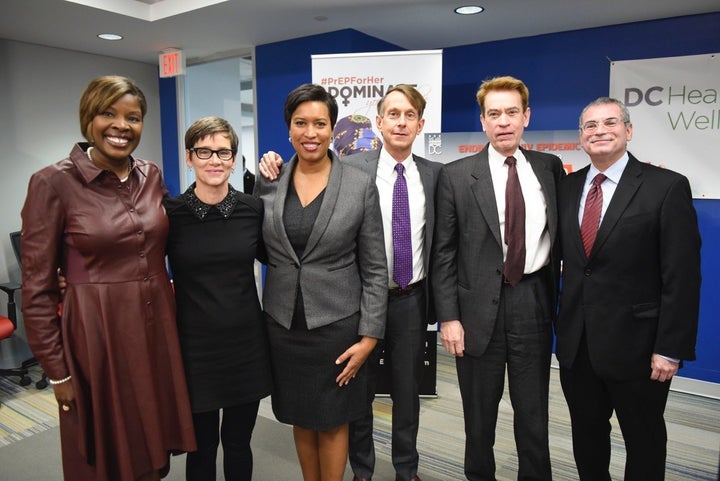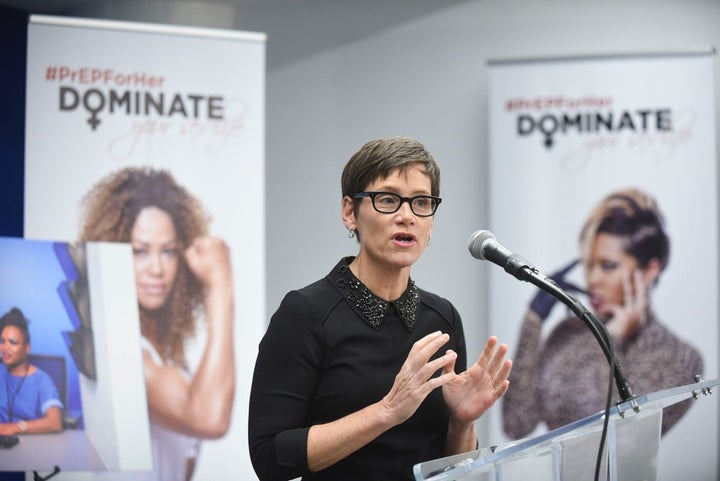
More than 13,000 people are living with HIV in Washington, D.C. That’s 2 percent of the city’s population, or double the rate that constitutes an “epidemic” in the eyes of the Centers for Disease Control and Prevention.
Nancy Mahon, global executive director of the MAC AIDS Fund, the philanthropic arm of the cosmetic company MAC, says it’s “shameful” that the infection rate is so high “in the backyard of our nation’s Capitol” ― especially given the United States’ leading role in funding international AIDS work.
While D.C.’s infection rate has fallen from its height of 3 percent in 2009 ― a rate that was higher than that of West Africa ― the level of infection is still unacceptable, said D.C. Mayor Muriel Bowser at an event Thursday kicking off the city’s newest plan to combat the epidemic.
Last year, Bowser and the city’s department of health announced that they would work with the Washington AIDS Partnership and the DC Appleseed Center for Law and Justice on an initiative to end the HIV epidemic in the District by 2020. The effort, they said, would be known as the 90/90/90/50 Plan.
They outlined the details of that plan on Thursday, during an event scheduled to coincide with World AIDS Day. The plan stresses four goals: to ensure that 90 percent of D.C. residents living with HIV will know their status; that 90 percent of people diagnosed with HIV will be in treatment; that 90 percent of people in treatment will achieve viral load suppression; and that there will be a 50 percent decrease in new HIV infections, all by 2020.
This plan builds on the 90-90-90 goals that UNAIDS, the United Nations organization committed to dealing with the disease, set out two years ago. D.C. joins New York state and San Francisco, which have set similar goals.
Those places are leading the charge nationally, said Dr. Anthony Fauci, director of the National Institute of Allergy and Infectious Disease. “This plan is the kind of thing that leads to a tidal wave of cities trying to copy cities,” Fauci told The Huffington Post. “The goal is that we should be striving for this worldwide, but if we can do this in the U.S. in high-level cities, this is a good step in the right direction.”
To achieve those goals, D.C. plans to build on the success of the city’s needle exchange program, which has reduced the number of new HIV cases among injection drug users by 95 percent since it was introduced in 2007. The city’s plans also include educational programs for health care providers, a push to reduce the stigma around the disease, and an effort to increase public awareness and accessibility of treatments like Pre-Exposure Prophylaxis, or PrEP ― a drug regimen used to prevent infections among people who are at high risk for contracting HIV. It also calls for renewed efforts to make sure D.C. residents have access to stable housing, which the plan’s authors say is essential to overall wellness goals.
“I don’t think it’s any mistake that both the mayor and the director [of the D.C. Department of Health] are African-American women, and they are the first people in the country to do this.”
- Nancy Mahon, global executive director of the MAC AIDS Fund
The MAC AIDS Fund has also provided a $1 million grant for a marketing campaign to encourage D.C.’s black women to use PrEP. Black women are the second highest at-risk group in the district, accounting for 1 in 6 new HIV diagnoses.
“I don’t think it’s any mistake that both the mayor and the director [of the D.C. Department of Health] are African-American women, and they are the first people in the country to do this,” Mahon said ― a reference to Bowser and to DOH’s Dr. LaQuandra Nesbitt.
The MAC AIDS Fund has donated a total of $8.7 million to D.C. over the past decade. The latest grant is part of its $6.6 million initiative aimed at curbing HIV rates in cities around the globe, with campaigns in Paris, Berlin, Mexico City and London.

Walter Smith, the executive director of DC Appleseed, a nonprofit organization dedicated to solving public policy problems in the nation’s capital, said Thursday that the innovation in D.C.’s 90/90/90/50 Plan lies in its public and private partnerships, which he hopes can serve as an example for other cities.
“Given where we started, we came from a situation where the District of Columbia was setting a bad example for the nation ― we all knew where we were with HIV/AIDS was absolutely unacceptable,” he said. “We have come so far [from] that with this plan. We are on the verge of setting a good example for the nation.”
Fauci went even further in his praise.
“The dynamics of plans like this,” he said, “can turn around outbreaks.”
